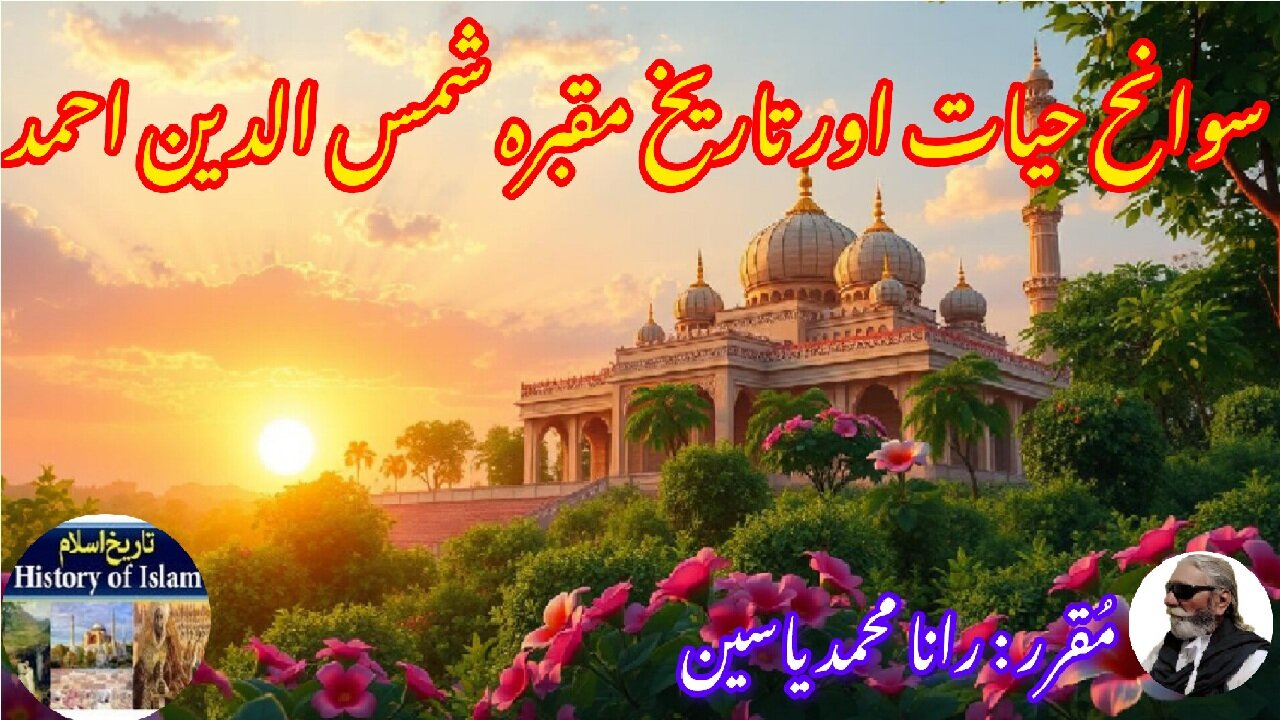Premium Only Content

Shamsuddin Ahmed and history of his shrine شمس الدین احمد کی سوانح عمری اور ان کے مزار کی تاریخ
@islamichistory813 #shamsuddin #ahmed #sufisaint #cultural #heritage #biography #islamic #mysticism #islamic #philosophy #shrine #historical #figures
Biography of Shamsuddin Ahmed and the history of his shrine
Dekhti Aankhooon aur sountay kaanoon ko Asslamoalaikum, sisters, brothers friends and elders, in informative series videos of Islamic ascolars, sufisaints, cultural heritages, islamic philosophys, islamic mysticisms and historical figures. today we are describing biography of Shamsuddin Ahmed and the history of his shrine.
Shamsuddin Ahmed, a revered Islamic scholar and Sufi saint, is widely recognized in the region of Lastimanika, located near the Meghna River in Comilla, Bangladesh. While there is limited documented history regarding the specific details of his life, his spiritual influence and dedication to Islamic teachings have left a lasting legacy in the area. He is known for his devout life, unwavering commitment to spreading the message of Islam, and his contributions to the spiritual development of his community. Shamsuddin Ahmed is particularly cherished for his wisdom, piety, and guidance, which earned him great respect among the local population of Comilla and surrounding regions.
Though much of Shamsuddin Ahmed's early life remains unclear, it is believed that he lived during the 18th century and passed away in the late 1800s. His death marks the end of a life dedicated to religious service and spiritual leadership, leaving a void that was deeply felt by his followers. His teachings and spiritual guidance, however, continue to inspire many to this day. Shamsuddin Ahmed’s legacy is not only preserved in the hearts of his devotees but also in the site where he was laid to rest: his shrine in Lastimanika, Comilla. His shrine has become an important spiritual and cultural landmark in the region, visited by people from across Bangladesh and beyond.
The shrine of Shamsuddin Ahmed is located in the serene and peaceful area of Lastimanika, which is situated by the Meghna River in Comilla District. The location of the shrine itself is significant, as it stands as a testament to his enduring spiritual influence in the region. After his death, his followers and local community members, who held him in great reverence, decided to construct a shrine over his final resting place. The shrine was built by his disciples and the local community, reflecting their deep devotion and respect for the scholar. Over time, the shrine has been expanded and maintained by successive generations, with each contribution further solidifying its role as a central spiritual site.
Shamsuddin Ahmed’s shrine is characterized by its simplicity and peaceful atmosphere, reflecting the humble nature of the saint himself. The structure of the shrine includes a small mausoleum that houses his grave, surrounded by a serene courtyard where visitors come to pray, reflect, and seek blessings. The area around the shrine has been landscaped to provide a tranquil environment, offering a place for devotees to find spiritual solace and connect with the divine through prayer and contemplation. The shrine also serves as a hub for local religious gatherings, including recitations of the Qur'an, Sufi poetry, and other devotional practices.
The shrine of Shamsuddin Ahmed has also become a focal point for the annual *urs* (death anniversary) celebrations, which are held to honor the life and teachings of the saint. During the *urs*, pilgrims from various parts of Bangladesh gather at the shrine to commemorate Shamsuddin Ahmed’s contributions to the spiritual and intellectual life of the region. These gatherings are marked by collective prayers, the recitation of Islamic scriptures, Sufi music, and offerings of food and gifts to the shrine. The *urs* provides an opportunity for the community to come together in a spirit of unity and reverence, celebrating the legacy of a man who dedicated his life to the service of Allah and the welfare of his fellow human beings.
The shrine has played a vital role in preserving the teachings of Shamsuddin Ahmed, and it continues to be an active center of worship and spiritual learning. It has also attracted a significant number of visitors who come not only to honor the memory of the saint but also to learn from his teachings and reflect on the deeper meanings of Islamic spirituality. In this way, Shamsuddin Ahmed’s influence endures, even in the face of time and change. His followers often describe him as a source of guidance and inspiration, and the shrine serves as a reminder of his wisdom, compassion, and dedication to the divine path.
The construction of Shamsuddin Ahmed’s shrine was initiated by his disciples and the local community, who sought to honor his legacy and provide a space for future generations to remember and draw inspiration from his life. The shrine was built with the collective effort of the community, and over the years, it has become an enduring symbol of the bond between the saint and his followers. Through their efforts, Shamsuddin Ahmed’s teachings continue to thrive, and his shrine remains an integral part of the spiritual landscape of Lastimanika and the broader Comilla region.
In conclusion, Shamsuddin Ahmed passed away in the late 1800s, leaving behind a profound spiritual legacy that is preserved at his shrine in Lastimanika, Comilla, Bangladesh. The shrine, built by his disciples and local community members, serves as a testament to his life and teachings, attracting devotees and pilgrims who come to seek blessings and reflect on his wisdom. Over time, the shrine has become a central place for religious gatherings, offering a space for spiritual solace, communal prayers, and the continued celebration of Shamsuddin Ahmed’s lasting influence on the spiritual life of the region. His shrine remains an enduring symbol of his devotion to Islam and his lasting impact on the hearts and minds of his followers.
With this, we seek your permission until tomorrow, tomorrow we will describe the biography of Mulla Fanari and the history of his Shrine.
Allah Hafiz
==============================
-
 13:50
13:50
ISLAMIC HISTORY
51 minutes agoIslamic History Episode 278 A brief look at the Islamic Empire {P-4} سلطنت اسلامیہ پر اجمالی نظر
1 -
 9:58
9:58
Clintonjaws
12 days ago $0.11 earnedKaroline Leavitt's Response To 'The View' Host's Nasty Attacks Is Perfect
26.9K16 -
 24:23
24:23
World2Briggs
20 hours ago $0.01 earnedTop 10 Towns You Can Retire on $1900 a month in the Pacific North West.
18.6K8 -
 21:23
21:23
Lady Decade
17 hours ago $0.03 earnedThe Lost Sega Neptune Console Refuses To Die !
27.3K4 -
 17:14
17:14
ThinkStory
22 hours agoIT: WELCOME TO DERRY Episode 2 Breakdown, Theories, & Details You Missed!
23.1K -
 17:25
17:25
Real Estate
1 month agoThe Job Market Collapse IS HERE
29.3K12 -
 2:04:54
2:04:54
BEK TV
1 day agoTrent Loos in the Morning - 11/05/2025
20.3K1 -
 LIVE
LIVE
The Bubba Army
23 hours agoUPS PLANE EXPLODES - What Went Wrong? - Bubba the Love Sponge® Show | 11/05/25
1,058 watching -
 16:38
16:38
James Klüg
21 hours agoFOOD STAMPS RAN OUT, Will People Loot?
30K36 -
 23:56
23:56
Producer Michael
20 hours agoBuying My Wife a $500,000 Diamond Necklace!
17.8K11